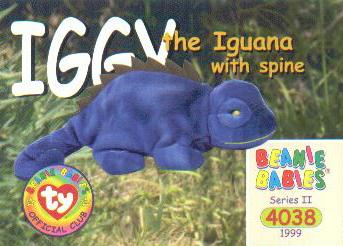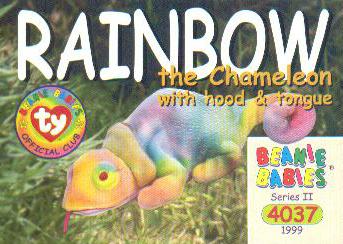A lot of you want to know how much your Iggy and Rainbow Beanie Babies are worth.
Iggy and Rainbow bid farewell as they were officially retired on March 31, 1999, among a group of other beanies. This announcement came as a surprise, delivered in the form of a puzzle featuring squares adorned with pictures of various beanies. Once again, Ty had mistakenly placed the wrong photos for Iggy and Rainbow in the puzzle, continuing the tradition of their introduction, which was initially mixed up. Farewell to Iggy and Rainbow, the most misunderstood of beanies!
The initial analysis revealed discrepancies. Rainbow, tagged as such, lacked the vibrant hues of a rainbow, appearing instead as a shade of blue. Conversely, Iggy sported fabric reminiscent of a rainbow, contradicting his namesake. A deeper dive into their accompanying poems hinted at a mix-up beyond mere tags.
Upon scrutinizing real iguanas and chameleons at the zoo, it became apparent that the beanies were indeed tagged correctly. Yet, the fabric and features remained perplexingly swapped. Further iterations of Iggy and Rainbow only added to the confusion, with various versions exhibiting distinct characteristics and even geographical variations.
Attempts to decipher the fabric variations proved challenging, with subtle differences complicating categorization. Clues from inspection stamps hinted at distinctions between “pastel” and “sherbet” colors, shedding light on the manufacturing process.
The transition from PVC to PE pellets and the evolving tag placements added layers to the saga. Despite Ty’s attempts to rectify the situation, errors persisted, permeating merchandise and online platforms.
Basically, Iggy has the spikes and Rainbow has the collar around the neck.
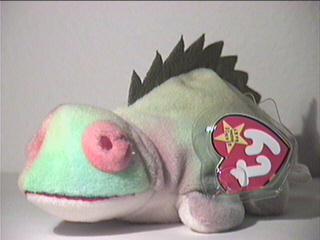
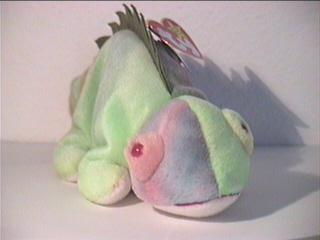
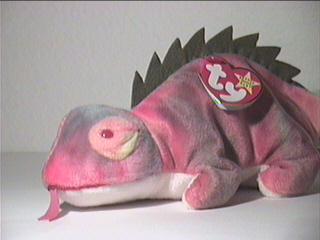
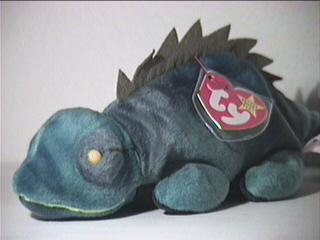
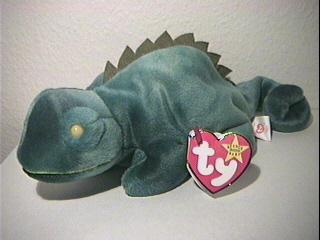
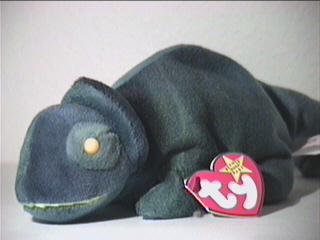
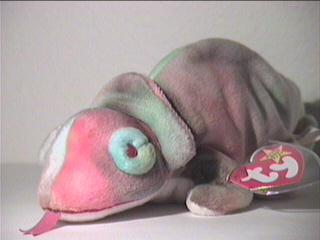
Rainbow’s hang tag poem:
“Red, green, blue and yellow, This chameleon is a colorful fellow. A blend of colors, his own unique hue, Rainbow was made especially for you!”
Iggy’s hang tag poem:
“Sitting on a rock, basking in the sun, Is this Iguana’s idea of fun. Towel and glasses, book and beach chair, His life is so perfect without a care!”
Basically, they have the right tag and name but the wrong fabric print was used.
In terms of value and pricing for the Beanie Babies Iggy and Rainbow in all variations, they are considered common and do not hold any collectible value.
Fabric:
The tie-dyed fabric discussed here may have two variations: a darker, “sherbet” coloring and a lighter, “pastel” coloring akin to “Pastel Peace” the bear. After examining numerous beanies, it’s noted that some exhibit a lighter, softer shade, though discerning whether this is a different material, section of the same fabric, or a result of different fabric suppliers remains unclear. Sorting a group of 24 beanies into “pastel” and “sherbet” color groups only adds to the confusion, as some beanies display both colorings. It’s a murky area, with no definitive determination of which variations feature which shades of rainbow-colored fabric.
Fabric (Update):
Special thanks to Roger, who may have uncovered a crucial clue regarding “pastel” versus “sherbet” fabric colors. While inspecting several specimens of Iggy #3, Roger noted that the red inspection stamp on the inside of the tush tag was oriented differently for “pastel” versus “sherbet” colored beanies. This insight simplifies sorting between the two color variations of Iggy #3.
Pellets:
The transition from PVC pellets to PE pellets in the early versions of Iggy and Rainbow raises questions about whether this change was deliberate or simply a matter of different factories using up different stock. Only Ty holds the answer, though they remain tight-lipped on the matter.
Tags:
Rainbow’s design likely necessitated the hang tag to be attached to its foot due to lack of practical alternatives. This placement is consistent across all versions of Rainbow, as well as Iggy #1 and the final version, Iggy #5. Hang tags were never swapped between Iggy and Rainbow during production runs, aside from occasional errors with hang tags or tush tags, primarily found in beanies manufactured in Indonesia and sold in the UK and Canada. The introduction of Iggy #3 saw the inclusion of a red stamp inside the tush tags, possibly serving as a factory identification.
Ty Memo, Website, & Merchandise:
Rumors suggest that Ty issued a memo shortly after Iggy & Rainbow’s release acknowledging the tag switch, though the existence of this memo remains unverified. The confusion extended to Ty’s website, which continued to display incorrect photos of Iggy & Rainbow even after the corrected versions were released. This discrepancy also affected Series I trading cards for Iggy and Rainbow. Despite the abundance of merchandise already in circulation, Ty eventually released corrected versions of the beanies, leaving collectors to navigate the inconsistencies between their merchandise and the new beanies.
Variation Chart For Ty Beanie Babies Iggy & Rainbow
| BEANIE | FABRIC | TONGUE? | EYE COLOR | HANG TAG LOC | TAG GEN | PELLETS | APPEARED |
| Iggy #1 | rainbow | no | red | left front foot | 5th | PVC or PE | Jan 1998 |
| Iggy #2 | rainbow | no | red | spine | 5th | PVC or PE | Jan 1998 |
| Iggy #3 | rainbow | yes | red | spine | 5th | PE | June 1998 |
| Iggy #4 | blue/green | no | yellow | spine | 5th | PE | Aug 1998 |
| Iggy #5 | blue/green | no | yellow | left front foot | 5th | PE | Feb 1999 |
| Rainbow #1 | blue/green | no | yellow | left front foot | 5th | PVC or PE | Jan 1998 |
| Rainbow #2 | rainbow | yes | red | left front foot | 5th | PE | Aug 1998 |
| Rainbow #3 | blue/green | no | yellow | left front foot | n/a | PE | May 1999 |
| Rainbow #4 | rainbow | yes | red | ? | n/a | PE | Jan 2000 |
In the world of collectible beanies, few incidents stir up as much excitement as a mix-up in fabrics. Such a mix-up occurred with the infamous Royal Blue Elephant, and now here with Iggy and Rainbow.
Ty corrected the fabric colors in the trading card set series II, as seen below. This is what Rainbow and Iggy were originally supposed to look like.
